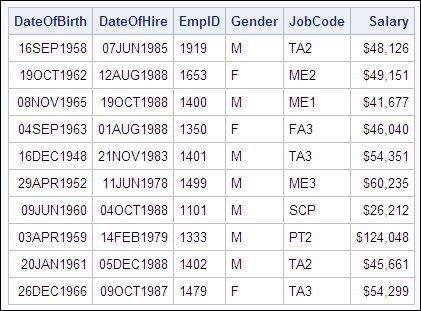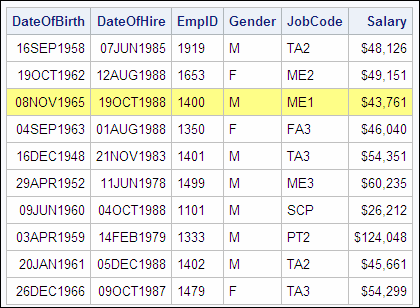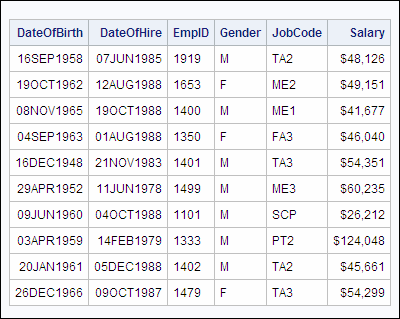Updating Values in Existing Table Rows
Overview
To modify data values in
some or all of the existing rows in a table, you use the UPDATE statement
in PROC SQL. In the UPDATE statement, for each column whose rows you
want to modify, you specify an expression that indicates how the values
should be modified. For example, the following expression indicates
that the values for the column Units should be multiplied by 4:
units=units*4
You can use the UPDATE
statement in two main ways.
|
Method of Updating Table
|
Example
|
|---|---|
|
update all (or a subset
of) rows in a column with the same expression
|
proc sql;
update work.payrollmaster_new
set salary=salary*1.05
where jobcode like '__1'; |
|
update different rows
in a column with different expressions
|
proc sql;
update work.payrollmaster_new
set salary=salary*
case when substr(jobcode,3,1)='1'
then 1.05
when substr(jobcode,3,1)='2'
then 1.10
when substr(jobcode,3,1)='3'
then 1.15
else 1.08
end; |
Note: The UPDATE statement does
not insert new rows into the table. To insert rows, you must use the
INSERT statement.
Note: You can also use the UPDATE
statement to update existing values in a table that underlies a PROC
SQL view. For details, see
Creating and Managing Views Using PROC SQL.
We consider each of
these methods for updating existing rows in a table.
Updating Rows By Using the Same Expression
To
update all (or a subset of) rows in a column with the same expression,
use an UPDATE statement that contains a SET clause and a possible
WHERE clause.
|
General form, basic
UPDATE statement for updating table rows:
UPDATE table-name
SET column-1=expression<,
... column-n=expression>>
<WHERE expression>;
table-name
specifies the name
of the table in which values are updated.
SET
specifies one or more
pairs of column names to be
updated, and expressions that
indicate how each column is to be updated.
WHERE
is used to specify
an expression that subsets
the rows to be updated.
|
CAUTION:
If you want to update
only a subset of rows in the table, you must specify a WHERE clause
or all rows of the table that are updated.
Example
Suppose a company is
considering giving all level-1 employees a 5% raise. Employee salaries
are stored in the table Sasuser.Payrollmaster. You do not want to
update the original table, so you create a temporary copy of Sasuser.Payrollmaster,
called Work.Payrollmaster_New. The following PROC SQL step creates
Work.Payrollmaster_New based on a query result and generates an output
report of the new table:
proc sql;
create table work.payrollmaster_new as
select *
from sasuser.payrollmaster;
select *
from work.payrollmaster_new;The first 10 rows of
Work.Payrollmaster_New, the table in which you update salaries, are
shown below.
Next, you write a PROC
SQL step that updates the specified rows. The UPDATE statement contains
both of the following:
-
a SET clause that specifies the expression to be used in updating Salary
-
a WHERE clause that specifies a subset of rows (level-1 employees) to be updated.
proc sql; update work.payrollmaster_new set salary=salary*1.05 where jobcode like '__1';
Finally, you can use
a SELECT statement to display the updated table as a report. The first
10 rows of Work.Payrollmaster_New, with updates, are shown below.
The third row lists
data for a level-1 employee, and that person's salary has been updated.
If you wanted to increase
all of the salaries, you would simply remove the WHERE clause from
the UPDATE statement:
proc sql;
update work.payrollmaster_new
set salary=salary*1.05;Updating Rows By Using Different Expressions
Sometimes you want
to use different expressions to modify values for different subsets
of rows within a column.
For example, instead
of only raising the salary of level-1 employees by 5%, you might also
want to raise the salaries of level-2 employees by 10%, and so on,
using a different percentage increase for each group of employees.
There
are two possible ways to use different expressions to update different
subsets of rows.
|
Method of Updating Table
|
Example
|
|---|---|
|
use multiple UPDATE
statements subset of rows
A single UPDATE statement
can contain only a single WHERE clause, so multiple UPDATE statements
are needed to specify expressions for multiple subsets of rows.
|
proc sql; update work.payrollmaster_new set salary=salary*1.05 where substr(jobcode,3,1)='1'; update work.payrollmaster_new set salary=salary*1.10 where substr(jobcode,3,1)='2'; update work.payrollmaster_new set salary=salary*1.15 where substr(jobcode,3,1)='3'; |
|
use a single UPDATE
statement that contains a CASE expression
|
proc sql; update work.payrollmaster_new set salary=salary* case when substr(jobcode,3,1)='1' then 1.05 when substr(jobcode,3,1)='2' then 1.10 when substr(jobcode,3,1)='3' then 1.15 else 1.08 end; |
The first method, which
requires the use of multiple UPDATE statements, is cumbersome because
the SET statement and expression must be repeated in each UPDATE statement.
In this example, the first method is inefficient because the table
Work.Payrollmaster_New must be read three times.
The second method, which
uses conditional processing (the CASE expression), is recommended.
We now consider the second method.
To update different subsets of rows
in a table in different ways, you can incorporate conditional processing
by using the CASE expression in the SET clause of an UPDATE statement.
The CASE expression selects result values that satisfy specified conditions.
|
General form, CASE expression:
CASE <case-operand>
WHEN when-condition THEN result-expression
<...WHEN when-condition THEN result-expression>
<ELSE result-expression>
END;
CASE
performs conditional
processing.
case-operand
is an optional expression
that resolves to a table column whose values are compared to all the when-conditions.
WHEN
specifies a when-condition,
a shortened expression that assumes case-operand as
one of its operands, and that resolves to true or false.
THEN
specifies a result-expression,
an expression that resolves to a value.
ELSE
specifies a result-expression,
which provides an alternate action if none of the when-conditions is
executed.
END
indicates the end of
the CASE expression.
|
CAUTION:
Although the ELSE clause
is optional, its use is strongly recommended. If you omit the ELSE
clause, each row that is not described in one of the WHEN clauses
receives a missing value for the column that you are updating.
Note: You can also use the CASE
expression in the INSERT and SELECT statements.
Example
In the following UPDATE
statement, the CASE expression contains three WHEN-THEN clauses that
specify three different subsets of rows in the table Work.Insure_New:
-
homeowners that are insured by Acme
-
homeowners that are insured by Reliable
-
homeowners that are insured by Homelife.
update work.insure_new
set pctinsured=pctinsured*
case
when company='ACME'
then 1.10
when company='RELIABLE'
then 1.15
when company='HOMELIFE'
then 1.25
else 1
end;PROC SQL updates each
specified subset of rows differently, according to the corresponding
WHEN-THEN (or ELSE) clause.
How PROC SQL Updates Rows Based on a CASE Expression
When you specify a CASE expression,
PROC SQL updates each row as follows:
The use of the CASE
expression is efficient because of how PROC SQL processes the WHEN-THEN
clauses. The WHEN-THEN clauses in the CASE expression are evaluated
sequentially. When a matching case is found, the THEN expression is
evaluated and set, and the remaining WHEN cases are not considered.
Example
Suppose a company is
considering giving raises to all of its employees, with a different
percentage for each employee level:
-
level-1 employees get a 5% raise
-
level-2 employees get a 10% raise
-
level-3 employees get a 15% raise.
First, you create the
temporary table Work.Payrollmaster3, which is a copy of Sasuser.Payrollmaster,
the table containing the employee salary data. The first 10 rows of
Work.Payrollmaster3 are shown below.
Next, you create a PROC
SQL step that updates rows by using an UPDATE statement that contains
a SET clause and a CASE expression:
proc sql; update work.payrollmaster3 set salary=salary* case when substr(jobcode,3,1)='1' then 1.05 when substr(jobcode,3,1)='2' then 1.10 when substr(jobcode,3,1)='3' then 1.15 else 1.08 end;
In this example, the
CASE expression contains three WHEN clauses, one for each subset of
rows (level-1, level-2, and level-3 employees), followed by an ELSE
clause to handle any rows that do not meet the expected conditions.
The first 10 rows of
Work.Payrollmaster3, after the rows have been updated, are shown below.
By comparing the values
of Salary in the original and updated versions of Work.Payrollmaster3
(as shown above), you can see how the values changed according to
the job level indicated in the JobCode.
Updating Rows By Using the CASE Expression with a Case Operand
If the expression in the
SET clause uses an equals (=) comparison
operator, you might use the optional case operand in the CASE expression.
Consider PROC SQL step that was shown in the preceding example, and
see how the CASE expression in the UPDATE statement can be rewritten
by using the alternate syntax.
Example
In the following PROC
SQL step, which was shown earlier, the CASE expression contains three
WHEN-THEN clauses. These clauses contain similar expressions, each
of which specifies the same SUBSTR function:
proc sql;
update work.payrollmaster_new2
set salary=salary*
case
when substr(jobcode,3,1)='1'
then 1.05
when substr(jobcode,3,1)='2'
then 1.10
when substr(jobcode,3,1)='3'
then 1.15
else 1.08
end;Because the expression
in this SET clause uses an equals (=) operator, you can restructure
the CASE expression for more efficient processing. In the alternate
syntax, the repeated SUBSTR function is removed from each WHEN-THEN
clause and is placed after the keyword CASE, as an operand:
proc sql;
update work.payrollmaster_new2
set salary=salary*
case substr(jobcode,3,1)
when '1'
then 1.05
when '2'
then 1.10
when '3'
then 1.15
else 1.08
end;Using the alternate
syntax, the SUBSTR function is evaluated only once, so this PROC SQL
step is more efficient than the original version.
Note: You might use the case operand
syntax only if the SET clause expression uses the equals (=) comparison
operator.
Example
Suppose you want to
generate an output report that displays employee names, job codes,
and job levels. Your PROC SQL query selects LastName and FirstName
from Sasuser.Staffmaster, and JobCode from Sasuser.Payrollmaster.
The SELECT statement must define JobLevel as a new column, because
it does not exist as a separate column in either table.
You want to assign the
values of JobLevel, based on the number at the end of each jobcode.
(The number at the end of each JobCode value is expected to be
1, 2,
or 3.) To create JobLevel, you can
use the case operand form of the CASE expression to specify the three
possible conditions (plus an ELSE condition, just in case).
The PROC SQL query is
shown below:
proc sql outobs=10;
select lastname, firstname, jobcode,
case substr(jobcode,3,1)
when '1'
then 'junior'
when '2'
then 'intermediate'
when '3'
then 'senior'
else 'none'
end as JobLevel
from sasuser.payrollmaster,
sasuser.staffmaster
where staffmaster.empid=
payrollmaster.empid; |
 |
The SELECT clause uses
the CASE expression to assign a value of
junior, intermediate, senior,
or none to each row in the new JobLevel
column.
..................Content has been hidden....................
You can't read the all page of ebook, please click here login for view all page.




